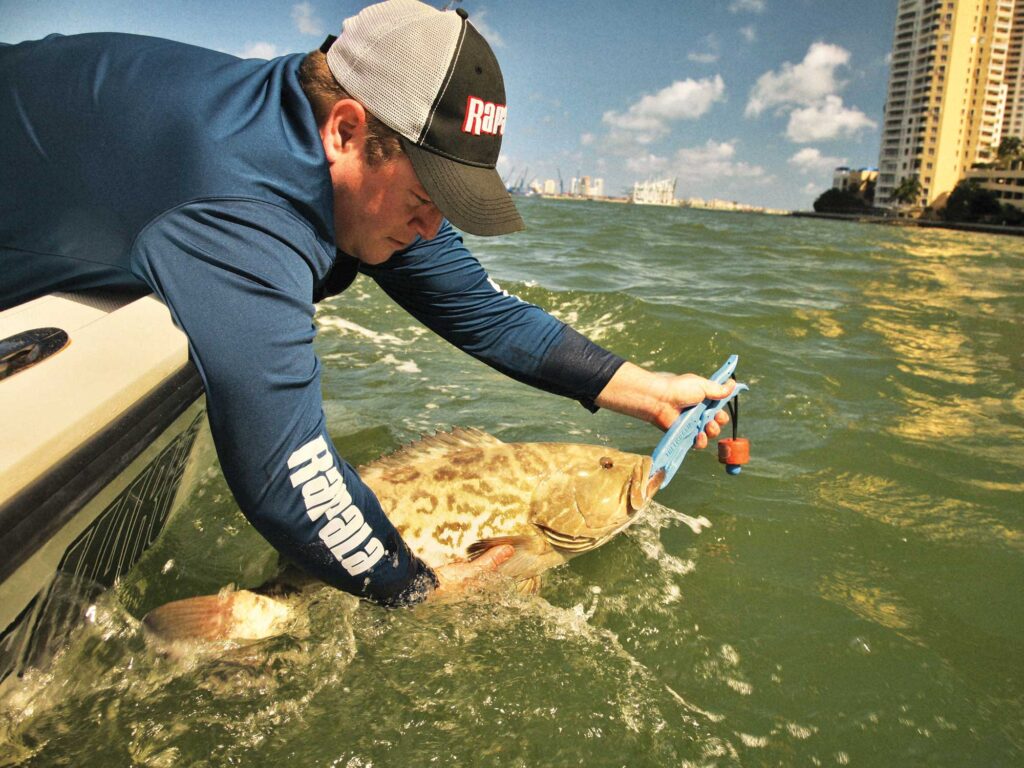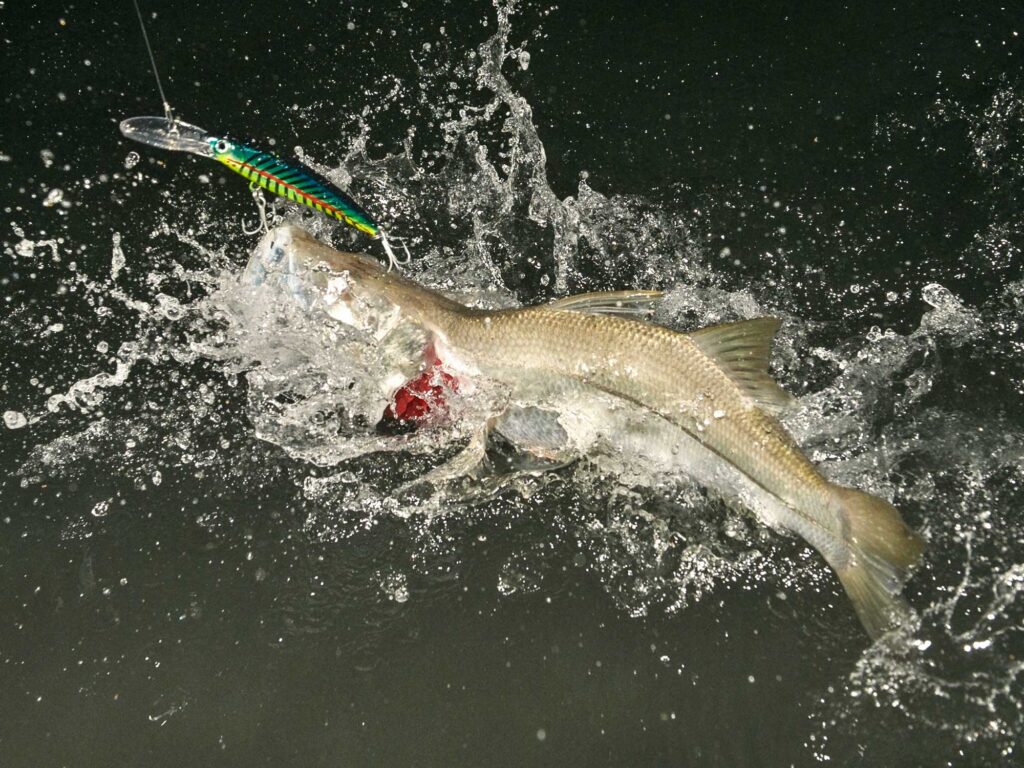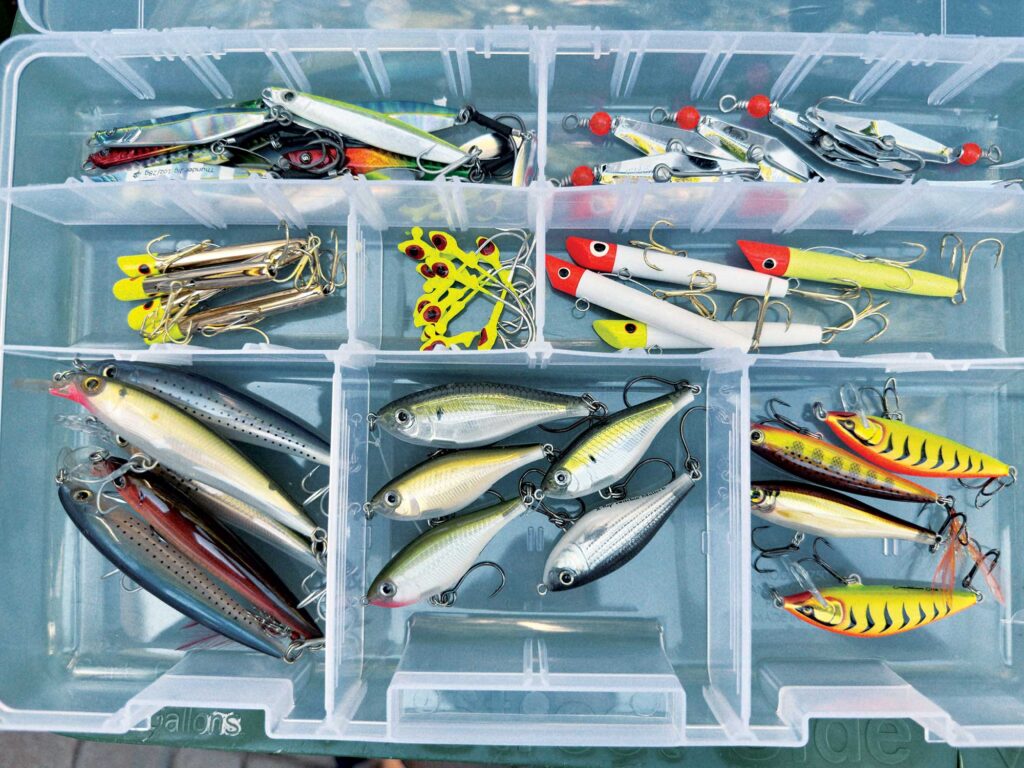Expert Tips for Inshore Trolling
 Trolling for grouper is productive in waters less than 15 feet, especially during spring. Check the seasons and regulations for keepers.
George Poveromo
Trolling for grouper is productive in waters less than 15 feet, especially during spring. Check the seasons and regulations for keepers.
George Poveromo
A steady drizzle of liquid sunshine kept us huddled underneath my T-top. Armani Garcia, Diego Toiran and I had just entered Hawk Channel by the Marquesas, some 28 miles west of Key West. This navigable, shallow belt averages 10 to 30 feet deep and spans along the Keys’ Atlantic side. During the cooler waters of winter and spring, an influx of bait and gamefish enters these shallows, hence what brought us here.
How Easy It IsWe trolled Rapala hard baits from two 10-pound-class spin outfits. One lure had a 30-pound fluorocarbon leader, the other a short trace of 27-pound titanium wire, since cero mackerel were around. For the next hour, we caught South Florida favorites such as yellowtail and yellow jacks—all by trolling these shallow-running plugs. Leader preference didn’t make a difference; both hard baits kept getting crushed. We added a deep-diving lipped plug down the center for grouper but were unsuccessful.
Catching inshore fish involves locating structure, bait and good tidal movement. We had one extra advantage for the area: a C-Map Reveal high-definition bathymetric chart. This shows in detail all nooks, crannies, depressions and bottom compositions. We identified the high-profile patch reefs and bars, then simply trolled parallel to and over them. The only time we dropped anchor was to enjoy a lunch of yellow jack poke freshly prepared by Garcia.
 Working lipped plugs in channels catches snook, but don’t discount lipless plugs or spoons when trolling shallower waters.
George Poveromo
Big Returns
Working lipped plugs in channels catches snook, but don’t discount lipless plugs or spoons when trolling shallower waters.
George Poveromo
Big Returns
Inshore brackish and saltwater channels, canals, rivers and creeks are ideal trolling environments, especially in unfamiliar waters. Trolling covers ground, significantly increasing the likelihood of dragging lures over drop-offs, shelves, rock piles, boulders and other fish-holding cover. When a hookup occurs over good -bottom, save the spot.
A variety of species readily belt small lures approaching 5 or 6 inches, whereas larger ones could intimidate estuary fish. Trolling also elicits competitive strikes; if multiple fish are around, there’s little time to analyze an offering. A trophy-class fish will surely consume a small offering. There’s no downside here.
Our Hawk Channel trolling setup was absurdly simple: Two small lures, light leaders and 10-pound-class spin tackle. Trolling between 2 and 5 mph, the plugs ran just under the surface while the outfits sat upright in gunwale holders. With ballyhoo being blitzed around us by yellow jacks and ceros, our surface-running baits proved successful.
To acquire more depth with shallow-running lures, simply hold an outfit’s rod tip just above the water. With the fishing line’s trajectory now more parallel with the surface, another 2 or 3 feet of depth is easy to gain, especially by slowing the boat. This tactic positions a lure closer to bottom-holding fish in shallow waters. I prefer holding my fishing outfit when inshore trolling, to precisely probe sections of the water column. This is especially beneficial when bait and gamefish are marking on the sonar and bottom compositions are erratic.
Don’t Overlook the ICWTrolling deep-running plugs above craggily bottom and along shelves and sudden drops requires surgeonlike precision. Potential rewards include grouper, snook, striped bass, tarpon and possibly cobia. Prime deep-trolling inshore environments include the Intracoastal Waterway, as well as major bay, sound and inlet bridges. Sometimes you might intersect with heavyweights navigating to and from oceans.
In Miami, cooler winter and spring waters concentrate gag grouper within the ICW. Trolling deep-diving plugs in 10 to 15 feet scores big here. It’s the same throughout the Florida Keys and along the state’s southwest and southeast coasts.
Because of the rough environment (such as rubble piles, ICW shelves and pilings), we rig the plugs with 100-pound fluorocarbon leader and use small conventional or medium spin tackle spooled with 50- or 80-pound braid. This is a hookup, heavy-drag, all-out-fight environment. The goal is to keep fish from breaking off. The rewards include gag grouper up to 10 pounds, big snook, and tarpon pushing 100 pounds.
Read Next: Top Tips for Fishing Topwaters Inshore and Offshore
 There’s a wealth of tackle choices for inshore trolling.
George Poveromo
Rock Bottom
There’s a wealth of tackle choices for inshore trolling.
George Poveromo
Rock Bottom
For this style of ICW and canal trolling, feather-back a pair of plugs with rod tips held inches above the surface. Once a plug bumps bottom, reel up a few feet and hold in place; it must ride near bottom without snagging, right where the grouper are. The boat operator maintains a trolling speed between 5 and 10 mph, and watches the sonar for bottom variations. For example, if I’m in 12 feet of water and the sonar shows a bottom rise of 2 or 3 feet, be it a large boulder, rock pile or other obstruction, we’ll raise our rods and reel up a few feet to swim the plugs over it. Once across, the plugs are repositioned. This is where communication is paramount.
A grouper will leave its lair to pursue a plug; don’t slow the boat on the strike or you’ll enable it to return to its sanctuary. Doubles are also possibilities, so keep that other plug in play. With the boat moving forward and heavy pressure applied, a hooked fish eventually rises to the surface.
The same tactics apply when trolling through inlets and parallel to long bridges: Feather-back the plug until it bumps bottom, reel it up a few feet, keep the rod tip aimed at the water’s surface, and don’t slow upon hooking up—plenty of big fish have been lost in groins and pilings from a slowing boat. If possible, turn and motor away from any hard structure, like a bridge. This tactic also applies to trophy striped bass, bull redfish, tarpon and other large bridge- and inlet-oriented gamefish.
Many anglers don’t associate trolling with inshore fishing. Yet it is an ideal opportunity to watch a sonar and intimately learn a stretch of water; numerous spots are uncovered this way.
Inshore trolling is a good alternative when adverse conditions hinder more traditional tactics. It’s a proven way to clean up on gamefish, including those you desire to bring home for dinner.
Pick a SpeciesInshore trolling can be as simple as what we were doing, or more complex by adding a topwater plug or chugger down the middle. Its splashing and skipping replicate a frantic, displaced bait. Try at least one deep diver to cover the bottom of the water column. In my travels, trolling plugs for inshore gamefish has produced striped bass, bluefish, seatrout, snook, tarpon, grouper, snapper, jacks, mackerel and even redfish.
The post Expert Tips for Inshore Trolling appeared first on Salt Water Sportsman.
- Home
- About Us
- Write For Us / Submit Content
- Advertising And Affiliates
- Feeds And Syndication
- Contact Us
- Login
- Privacy
All Rights Reserved. Copyright , Central Coast Communications, Inc.